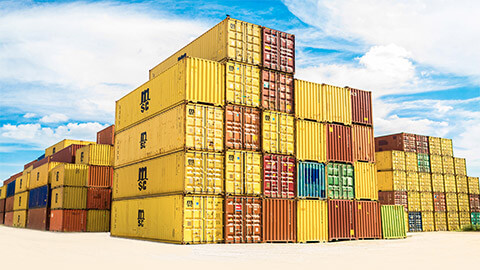International trade is about expanding your business overseas by importing goods or services to or exporting them from another country. International trade has allowed new and existing entrepreneurs to thrive, providing many possibilities and opportunities. On the other hand, the 2008 global financial crisis and the COVID-19 global pandemic are excellent examples of the worst effects of globalisation and international trade.
Financing international trade is a complicated process. Some key considerations include changing foreign currency exchange rates, shipping documents and custom regulations. The specific steps required, though, tend to differ from business to business and transaction to transaction.
Welcome to Topic 11: International Finance and Trade. In this topic, you will learn about:
- International trade finance
- Factors that affect currency exchange rates
- How to manage the exchange risk
- Financing international business.
These relate to the Subject Learning Outcomes:
- Understand the role of the finance and accounting functions in an organisation.
- Develop analytical skills drawing from key finance theories, concepts and techniques.
Welcome to your pre-seminar learning tasks for this week. Please ensure you complete these prior to attending your scheduled seminar with your lecturer.
Click on each of the following headings to read more about what is required for each of your pre-seminar learning tasks.
Read Chapter 6 of the prescribed text - Melicher, RW & Norton, EA 2017, Introduction to finance: Markets, investments, and financial management, 16th edn., John Wiley & Sons, Inc.
Read the following journal articles:
- Chugunov, I & Kucher, H 2020, ‘International finance in the conditions of globalization’, Foreign trade: economics, finance, law, 113(6):67-82.
- Lai, K, Wang, T & Xu, D 2019, ‘Capital Controls and International Trade: An Industry Financial Vulnerability Perspective’, Journal of International Money and Finance, 116:102-399.
- Yilmazkuday, H 2021, ‘Accounting for trade deficits’, Journal of International Money and Finance, 115:102-385.
Identify the key takeouts from the articles and add these to your reflective journal. You can access the reflective journal by clicking on ‘Journal’ in the navigation bar for this subject.
If you are unsure of any concepts, reach out to your lecturer.
Read the following web article:
- Tutorials Point n.d., International Trade Finance.
Read the article, ‘Impact of online shopping on consumer buying behaviour: A case study of Jumia Kenya, Nairobi’.
Then consider Discussion question 3 on p. 150 of the prescribed text, which focuses on the risks of direct online shopping and buying from a foreign manufacturer. Make a note of your answers in your reflective journal and be ready to share your reflections with the class during the scheduled seminar.
This topic has a discussion forum activity, which will enhance your knowledge and give you the opportunity to interact with your peers. You can access the activity by clicking on the following link. You can also navigate to the forum by clicking on 'FIN100 Subject Forum' in the navigation bar for this subject.
Read and watch the following content.

International trade finance
A good business always looks for ways to expand its market, and an excellent way of doing that is to find access to international markets. The organisation can start importing high-quality goods and services for a lower price, and/or it can export its goods and service to new, bigger and better markets overseas.
International trade finance works as the intermediary between the demand and supply to ensure this entire process runs transparently and smoothly. Usually, banks and other financial institutions, authorised to handle international markets, assist importers and exporters by providing credit accreditations and bank guarantees. Financial institutions help minimise the supply and payment risks between buyers and sellers by acting as an intermediary.
Key terms of international trade finance
The following terms are vital for understanding international trade finance:
Letter of credit
A letter of credit is proof of funds issued by any bank or financial institution on behalf of the buyers, guaranteeing that the sellers will get the full payment in exchange for their goods and services delivered on time. In the instances where the buyers cannot pay, the bank will pay the seller in part or in full, according to the terms and conditions of the issued letter of credit.
Bank guarantee
A bank also issues a bank guarantee. In this situation, the bank acts as a guarantor if the importer or exporter cannot fulfil the terms and conditions of the contract.
Factoring
Factoring occurs when the companies are paid on the base percentage of their accounts receivables. The exporter sells their invoices to the trade financier at a discounted rate. Then the factoring agent sells it to the importer and gets the total price for the product.
Export credit
Export credit can be delivered to exporters as working capital. Once the buyer receives the amount, the export packing credit amount is adjusted. Then, the loan is closed against the order.
Forfaiting
Forfaiting occurs when the exporter sells all their accounts to a forfaiter at a discounted rate in exchange for cash.
Insurance
You can use insurance for shipping and the delivery of goods and protect the exporter from non-payment by the buyer.
Financing international business

According to Melicher & Norton (2017), one of the substantial financial burdens of any industrial business is the process of manufacturing itself. When a manufacturer exports goods to distant places, funds are tied up not only for the period of manufacture but also for a lengthy transportation period. To reduce costs, manufacturers may require the foreign importer to pay for the goods when the transaction occurs rather than on delivery. This technique transfers a substantial financial burden to the importer.
The following are some other benefits of international trade finance:
- Allows businesses to grow into overseas markets and open more revenue streams
- Eliminates the non-payment risk from overseas customers
- With the help of financial intermediaries, buyers can place bulk orders and reduce their per unit cost
- Provide less risky repetitive trade arrangements opportunities, which creates a healthy bond between the supplier and the buyer.
Factors that affect currency exchange rates

Since producers, consumers and investors in different countries use different currencies, the international financial system requires mechanisms to establish relative values (or exchange rates) between currencies and handle their actual exchange. Under the system of flexible exchange rates, which began in 1973, supply and demand in the foreign exchange market determine the exchange rate and drive the exchange process. This system reduces the impact of international financial transactions on domestic money supplies. “Still, changes in exchange rates do affect imports and exports and can, thus, affect domestic production, incomes, and prices. International financial markets strongly influence domestic interest rates, and vice versa, so that domestic monetary policy still involves international considerations” (Melicher & Norton 2017, p. 151).
Many factors in the market cause the exchange rate to fluctuate. However, supply and demand equilibria are the leading cause of fluctuations. In simple terms, if more currency leaves your economy (to pay for imports) to move into another economy, the value of your currency will fall in comparison to the foreign currency (exporter’s currency). The country's inflation rate, political environment, trade policies and tariffs, relative interest rates, socioeconomic risks and many other factors also contribute to exchange rates. For example, Melicher & Norton (2017) stated that if inflation is lower in the United States relative to Eurozone member countries, Eurozone member products of comparable quality will become increasingly expensive. The following table is a snapshot of the Australian Dollar exchange rates on January 6, 2022. To see the current exchange rates, go to the X-Rates website, where you can also check the exchange rates for other currencies by using the drop-down menus on the left of the page.
| As of January 6, 2022, 12:14 UTC | ||
| Australian Dollar | 1.00 AUD | Inv. 1.00 AUD |
|---|---|---|
| US Dollar | 0.717032 | 1.394639 |
| Euro | 0.634009 | 1.577265 |
| British Pound | 0.529600 | 1.888218 |
| Indian Rupee | 53.405083 | 0.018725 |
| Canadian Dollar | 0.915868 | 1.091861 |
| Singapore Dollar | 0.975300 | 1.025326 |
| Swiss Franc | 0.658489 | 1.518629 |
| Malaysian Ringgit | 3.020783 | 0.331040 |
| Japanese Yen | 83.035114 | 0.012043 |
| Chinese Yuan Renminbi | 4.573520 | 0.218650 |
Direct and indirect quotes
There are two (2) ways of presenting an exchange rate quote:
A direct quote is a listing of the exchange rate itself, from domestic to foreign currency. For example, if you wanted to exchange AUD (domestic currency) for EUR (foreign currency), the AUD/EUR exchange rate is your direct quote. It is a measure of the amount of foreign currency (in this example, Euros) that one unit of the domestic currency (in this example, Australian Dollars) can ‘buy’.
In contrast, an indirect quote is the reverse – it is the amount of domestic currency that one unit of foreign currency can ‘buy’. To calculate an indirect quote, divide 1 by the direct quote, as shown in the following example:
- Direct quote
- Indirect quote.
$$\begin{aligned}\mathsf{Direct\;(AUD/USD)}&=0.717032\\\mathsf{Indirect\;(USD/AUD)}&=\frac{1}{\mathsf{direct\;(AUD/USD)}}\\\\&=\frac{1}{0.1717032}\\\\&=1.394638\end{aligned}$$
In the previous table, AUD (Australian Dollars) is the base currency. The direct quotes for the exchange rates from AUD to foreign currencies are listed in the central column, while the indirect quotes are listed in the right-hand column.
Accounting treatment
The concept of ‘monetary items’ is fundamental to accounting for foreign currency transactions. The Australian Accounting Standards Board (AASB) 121/IAS 21 defines monetary items to mean units of currency held and assets and liabilities to be received or paid in a fixed or determinable amount of currency. Therefore, monetary item refers to cash or another item that constitutes a claim to cash or an obligation to pay cash.
AASB 121/IAS 21 also defines a foreign exchange difference as the difference resulting from translating a given number of units of one currency into another currency at different exchange rates. Exchange differences arise whenever a foreign currency balance is remeasured using an exchange rate different from the one applied previously. Furthermore, exchange gains (losses) on a monetary asset arise if there is an increase (decrease) in the direct rate of exchange or decrease (increase) in the indirect rate of exchange. The opposite applies for monetary liabilities.
How to manage exchange risk

Currency exchange rate risk is the price risk associated with fluctuating exchange rates over time. For example, a business transaction conducted at today's Australian Dollar (AUD) to British Pound (GBP) exchange rate with payment due immediately would not be subject to currency exchange rate risk. However, if the payment takes place sometime after the transaction, the AUD/GBP exchange rate may change in that time, causing the final transaction to be more (or less) costly.
“While mutinational corporations, as well as individuals and institutional investors, may engage in foreign exchange speculation as opportunities arise, risk reduction is their primary goal. Among the possible actions of foreign exchange specialists are hedging, adjusting accounts receivable and payable procedures, cash management, and borrowing and lending activities. Existing or anticipated variations in the value of foreign currencies guide all these actions” (Melicher & Norton 2017, p. 144).
Hedging
"Hedging is an action taken to reduce risk or insure against a possible negative outcome. A multinational corporation may want to lock in an exchange rate at which a currency can be obtained at in the future. For example, a multinational corporation with a claim for payment within 90 days may anticipate a possible decline in the currency value of the customer's country. The seller can hedge by entering into a financial contract for the delivery of that currency at the existing exchange rate on the day of the contract. To accomplish the hedge, the multinational corporation might enter into a forward contract that specifies the currencies to be exchanged, an exchange rate, and a future date when the transaction will be completed. The exchange rate specified in the forward contract is called the forward rate. The terms of the forward contract are established between the multinational corporation and a bank or other institutional foreign exchange dealer. Other financial instruments available for currency hedging activities include currency futures contracts and currency options contracts” (Melicher & Norton 2017, p. 144).
What is the difference between a forward and a swap?
Forwards and swaps are both types of derivatives that help organisations and individuals hedge against risks. Hedging against financial loss is essential in volatile marketplaces. Forwards and swaps are instruments that allow the buyer to guard against the risk of making losses. Another similarity between swaps and forwards is that neither are traded on organised exchanges.
The significant difference between these derivatives is that swaps result in several payments in the future, whereas the forward contract will result in one future payment.
Some other points of distinction include:
- Derivatives are special financial instruments that derive value from one (1) or more underlying assets. Forwards and swaps are both types of derivatives that help organisations and individuals hedge against risks.
- A forward contract is a contract that promises delivery of the underlying asset, at a specified future date of delivery, at an agreed-upon price stated in the agreement.
- A swap is a contract between two (2) parties that agree to swap cash flows on a date set in the future.
In summary, financing intermediaries are the lifeblood of international trade. They eliminate so many uncertainties from the equation and help suppliers and buyers enter into trade contracts. Financial institutions also use various instruments in the financial markets, such as hedging, swaps and forward contracts to eliminate or minimise the risks inherent in international trade.
Key takeouts
Congratulations, we made it to the end of the eleventh topic. Some key takeouts from Topic 11:
- International trade finance helps the global economy.
- Financial intermediaries assist suppliers and buyers reduce the risk of non-payment.
- Exchange rate differences occur due to many factors, such as:
- Supply and demand of monetary instruments
- Interest rates
- Political environment
- Government policies.
- Hedging, swaps and forward contracts are used to eliminate foreign exchange risks.
Welcome to your seminar for this topic. Your lecturer will start a video stream during your scheduled class time. You can access your scheduled class by clicking on ‘Live Sessions’ found within your navigation bar and locating the relevant day/class or by clicking on the following link and then clicking 'Join' to enter the class.
Click here to access your seminar.
The following learning tasks will be completed during the seminar with your lecturer. Should you be unable to attend, you will be able to watch the recording, which can be found via the following link or by navigating to the class through ‘Live Sessions’ via your navigation bar.
Click here to access the recording. (Please note: this will be available shortly after the live session has ended.)

In-seminar learning tasks
The in-seminar learning tasks identified below will be completed during the scheduled seminar. Your lecturer will guide you through these tasks. Click on each of the following headings to read more about the requirements for each of your in-seminar learning tasks.
Watch the video, Imports, Exports, and Exchange Rates: Crash Course Economics #15.
Working in a breakout room team assigned by your lecturer during the scheduled seminar, discuss the following questions with your teammates. Your lecturer will request that you present the findings back to the class.
- Describe how international trade emerged.
- How does globalisation create ‘winners and losers’?
- What are the downfalls of globalisation? Why do they exist, and how can they be avoided?
Watch the video, Will covid kill globalisation?, about the impact of COVID-19 on globalisation and, specifically, on the clothing industry.
After watching the video, working in the same breakout room as previously, discuss the content with your teammates. Then answer the following questions individually in your reflective journal.
- How did ZARA manage the risk of COVID?
- What business sectors managed to expand their businesses with and/or after COVID? Describe how they achieved their expansions.
Welcome to your post-seminar learning tasks for this week. Please ensure you complete these after attending your scheduled seminar with your lecturer. Your lecturer will advise you if any of these are to be completed during your consultation session. Click on each of the following headings to read more about the requirements for each of your post-seminar learning tasks.
Knowledge check
Complete the following three (3) tasks. The following questions have been taken from p. 142 of Melicher, RW & Norton, EA 2017, Introduction to finance: Markets, investments, and financial management, 16th edn., John Wiley & Sons, Inc.
Click the arrows to navigate between the tasks.
In your reflective journal, distinguish between a fair value hedge and a cash flow hedge that uses a forward exchange contract as the hedging instrument. Describe the accounting treatment of any gains or losses on a forward contract that qualify for hedge accounting.
Knowledge check
Complete the following three (3) tasks. The following questions have been taken from p. 150 of Melicher, RW & Norton, EA 2017, Introduction to finance: Markets, investments, and financial management, 16th edn., John Wiley & Sons, Inc.
Click the arrows to navigate between the tasks.
Start writing the report for Assessment 4 and think about the recommendations you will provide the client. You can access the instructions by clicking “Assessment 4” in the navigation bar for this subject.
Each week you will have a consultation session, which will be facilitated by your lecturer. You can join in and work with your peers on activities relating to this subject. These session times and activities will be communicated to you by your lecturer each week. Your lecturer will start a video stream during your scheduled class time. You can access your scheduled class by clicking on ‘Live Sessions’ found within your navigation bar and locating the relevant day/class or by clicking on the following link and then clicking 'Join' to enter the class.
Click here to access your consultation session.
Should you be unable to attend, you will be able to watch the recording, which can be found via the following link or by navigating to the class through ‘Live Sessions’ via your navigation bar.
Click here to access the recording. (Please note: this will be available shortly after the live session has ended.)

- Moradi, A 2022, 'An analysis of the social distancing effects on global economy and international finance using causal loop diagrams', Decision Analytics Journal, 2:100023.
- Obstfeld, M 2007, 'International Finance and Growth in Developing Countries: What Have We Learned?', IMF Staff Papers, 56(1):63–111.
- Pilbeam, K 2013, International Finance, 4th Edn., Bloomsbury Publishing.
References
- Banque, E 2020, What Is International Trade Finance? How Does It Works And Types, Emeriobanque, https://www.emeriobanque.com/blogs/what-is-international-trade-finance-how-does-it-work-and-types#:~:text=What%20Is%20International%20Trade%20Finance%3F%20Trade%20finance%20is,instruments%20like%20bank%20guarantee%2C%20letter%20of%20credit%20etc.
- Chugunov, I & Kucher, H 2020, ‘International finance in the conditions of globalization’, Foreign trade: economics, finance, law, 113(6):67-82. https://www.sciencedirect.com/science/article/pii/S1877705814019341
- Crash Course 2015, Imports, Exports, and Exchange Rates: Crash Course Economics #15, streaming video, YouTube, https://www.youtube.com/watch?v=geoe-6NBy10
- DifferenceBetween 2012, Difference Between Swap and Forward, https://www.differencebetween.com/difference-between-swap-and-vs-forward/
- The Economist 2020, Will covid kill globalisation? | The Economist, streaming video, YouTube, https://www.youtube.com/watch?v=KJhlo6DtJIk
- Hilmola, O 2021, ‘Inflation and Hyperinflation Countries in 2018–2020: Risks of Different Assets and Foreign Trade’, Journal of risk and financial management, 14(2):618, https://www.mdpi.com/1911-8074/14/12/618
- Kibandi, EN & Reuben, JM 2019, ‘Impact of online shopping on consumer buying behaviour: A case study of Jumia Kenya, Nairobi’, Global Scientific Journals, 7(11):116-135.
- Lai, K, Wang, T & Xu, D 2019, ‘Capital controls and international trade: An industry financial vulnerability perspective’, Journal of International Money and Finance, 116:102-399.
- Melicher, RW & Norton, EA 2017, Introduction to finance: Markets, investments, and financial management, 16th edn., John Wiley & Sons, Inc.
- Tutorials Point n.d., International Trade Finance, https://www.tutorialspoint.com/international_finance/international_trade_finance.htm
- X-Rates n.d., Australian Dollar Exchange Rate Table, https://www.x-rates.com/table/?from=AUD&amount=1
- Yilmazkuday, H 2021, ‘Accounting for trade deficits’, Journal of International Money and Finance, 115:102-385.

